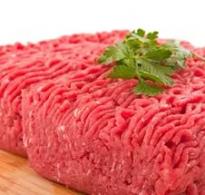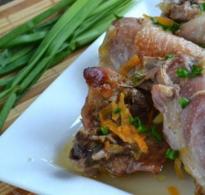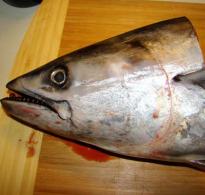Pelamida fish - cooking recipe. Cooking recipes and properties of bonito
Taste qualities and benefits of bonito fish. Cooking recipes with detailed descriptions. What can be made from bonito.
The fact that mackerel is considered the closest relative of bonito is not difficult to guess even from one cursory glance at this fish. Its back is covered with a beautiful marble pattern that closely resembles mackerel.
A distinctive feature of bonito is its larger size. She grows up to 85 cm and can weigh about 7 kg. Just like mackerel and tuna (the second relative of this fish), bonito is a predator.
She eats horse mackerel, young mullet, anchovy and does not even disdain young animals of her own species and her closest relative - mackerel. Pelamida is considered a valuable commercial fish.
In the last century, it was massively caught by fishermen from the Black Sea region, due to which its number has greatly decreased. At the end of the twentieth century, this fish practically disappeared from the Black Sea.
At present, it is sometimes found off the coast of the Crimea, but rather rarely. However, its numbers are starting to recover. In the Black Sea, bonito spends the summer, where it feeds and sometimes spawns, and in the fall it leaves to the south through the Bosphorus.
There are 4 varieties of this fish. But most often the Atlantic is on our table. By the way, on the shelves of our stores, bonito is sometimes found under the name "bonito".
The obvious benefits of bonito
- The meat of this fish contains a rich chemical composition. It contains a lot of useful trace elements such as zinc, sulfur, sodium, iodine, potassium and phosphorus. And also a large amount of vitamins.
- Its regular consumption stimulates the formation of hemoglobin, promotes tissue regeneration, and improves nutrition of the brain and spinal cord.
- The animal protein contained in bonito meat is almost completely absorbed by the human body. Nutritionists recommend eating it for pregnant and lactating women and children.
Cooking recipes and properties of bonito
It is not for nothing that Bonito is referred to as small tuna. Its meat tastes like this valuable fish. And given the inexpensive cost, it is not surprising that it has become so widespread. Bonito meat is fat (can contain up to 12% fat), dark in color and very nutritious.
However, it has a slightly specific smell and taste that can be easily removed if properly prepared. Most often bonito is smoked, salted, canned. Although, of course, you can cook a lot of completely different dishes from it.
Most often it gets to the shelves of our stores frozen whole. In the kitchen of a real hostess, nothing should be lost, so it is advisable to use all parts of the fish for cooking.
For example, the head, fins and tail can be used to make a great fish soup. Taking into account the high fat content of bonito, the soup from it turns out to be very tasty and rich. Try adding millet and more vegetables to it - the success of the dish will be guaranteed.
The rest of the fish can be salted, baked or fried. It turns out very tasty bonito in the oven with sour cream:
- Sprinkle the pieces of fish with lemon juice and fish spices (you can take oregano, thyme), salt. Let it sit for about 20 minutes.
- Then put the onion rings on a piece of foil, put the fish steak on top, pour with sour cream, bake in the oven for about 20 minutes.
- ... Put prepared fish steaks in brine for half an hour. To prepare it, boil a liter of water with 2 tablespoons of salt and a tablespoon of sugar and cool to room temperature.
- Then transfer the fish pieces to the parchment, place a piece of butter on top and bake in the oven for 15 minutes.
- With vegetables. Pre-marinate the steaks in lemon juice and herbs.
- Transfer to foil, sprinkle with chopped vegetables - bell peppers, carrots, onions, green peas, asparagus.
- Wrap and bake for about 20 minutes.
In the process of baking in the oven, the main thing is not to overdry the fish. Otherwise, it will become dry, tough and tasteless.
You can also cook grilled bonito... To do this, marinate it for 1-3 hours. For the marinade, you can use lemon juice mixed with vegetable oil or soy sauce. As well as herbs and crushed garlic.
Grill the bonito for about three minutes on each side. In this case, the thickness of the steaks should be no more than 2-3 cm.
Usually two methods are used for this: dry and in brine. Before salting, you need to remove the ridge - the pieces of fish should be boneless and their thickness should not exceed 3 cm, otherwise they will be salted for a very long time.
The dry method is no different from. If you chose the second method, you will need to prepare a brine at the rate of 2.5 tablespoons of salt, a tablespoon of sugar per liter of water.
All this is boiled, sweet peas, bay leaves are added, then cooled to room temperature. The fish pieces are poured with the resulting brine and left in the refrigerator for at least 12 hours. The longer the fish is in the brine, the saltier it becomes.
What else can you make with bonito?
- Pate... For this, the fish is boiled. You can use the head and tail left over, for example, after cooking fish soup. The meat is stripped of bones and skin, then twisted in a meat grinder, then whipped with butter in a blender. If desired, you can add herbs to the pate. Serve the finished pate with toast to a platter of soup.
- Stroganin... A very popular dish in the North. Prepared from raw and frozen fish. Naturally, it must be of excellent quality. For cooking, peel off the skin and cut off thin pieces of meat with a sharpened knife, preferably very thin, almost transparent and curled after cutting. To get just such pieces of meat, the bonito must still be frozen. Then onions are cut into half rings, mixed with fish. The finished dish must be seasoned with salt and pepper to taste and can be eaten. Traditionally, vodka is served with stroganin.
- Fried pelamida... To prevent the dish from turning out dry, the fish pieces must be marinated before cooking. Try soy sauce for this, add a pinch of ground ginger and pepper to make it spicy and savory, and marinate for about 20 minutes. Then simply fry in a small amount of oil on both sides until golden brown. Then reduce heat, cover and simmer for about 5-7 minutes (depending on the thickness of the pieces).
Pelamida is a very tasty and healthy fish. In addition, the price for it is quite democratic. You can cook a lot of different dishes with it. It will surely take root in your kitchen.
Application:
Tuna flakes are sprinkled on hot rice, fried potatoes or mashed potatoes, fettuccine, scrambled eggs, unsweetened open pie or pizza. Add to salads for piquancy. Uramaki rolls are decorated with tuna shavings.
Taste: neutral, fishy.
Color: pinkish brown shades.
Aroma: fishy, pleasant.
Additional properties: tuna flakes contain phosphorus, vitamin D, omega-3 fatty acids and selenium; shavings are in the form of small and large thin flakes.
Nutritional value per 100 g: protein 50.9 g; fat 2.3 g; carbohydrates 6.2 g
Energy value: 249 kcal
On a note:
In Japanese cuisine, tuna chips are used to flavor broths, as an ingredient in Miso and Suimono soups, as well as to prepare various sauces.
It is sprinkled with it on Takoyaki and the famous Japanese fried flatbread Okonomiyaki - "Japanese pizza". Tuna chips are also used as a filling for Onigiri, as well as for cooking Bento.
The process of making shavings is multi-stage. The Katsuobushi striped tuna fillets are smoked and dried to remove all fat. After that they are dried in the sun for a long time until the fillet acquires the hardness of a stone. Then they plan on a special board. The shavings are so thin and transparent that using them as a decorative seasoning for hot side dishes, you can observe a funny visual effect - from the steam, thin tuna flakes will dance like flowers in the wind.
bonito tuna shavings
Cooking secret:
To give the rolls a beautiful and regular shape, evenly pour the tuna shavings and roll the resulting rolls in it. You can fix the shavings with a bamboo mat, pressing it against the rolls.
Attention:
Remember that it is best to keep in moderation when using the shavings as a seasoning - do not overdo it by adding tuna shavings to various dishes.
We recommend using tuna shavings in combination with Philadelphia cheese, eel, tuna, fresh cucumber and avocado, Japanese round-grain rice and noodles. An excellent flavor combination is obtained with crab meat, cold tofu, braised asparagus and black sesame seeds.
use of tuna shavings in Japanese cuisine
Tofu fried in bonito tuna shavings
Cut the tofu block into small cubes and blot off any excess moisture with a paper towel. Dip each cube in flour and then dip in a pre-broken egg. Further similarly in sesame seeds and tuna shavings. Saute lightly in a skillet using sesame oil or aromatic vegetable oil. We recommend decorating the finished cubes with parsley or cilantro leaves.
photo recipe with bonito tuna shavings
Storage:
At storage temperatures between + 10 ° C and + 25 ° C for about 12 months.
When stored at -18 ° C, approx. 24 months.
Ingredients: tuna.
Country of origin: China
Chips of tuna (bonito) China 500 g
Latin name bonito- Sarda sarda, Mackerel family. That is, according to systematics, she is a relative of tuna and mackerel. Those who attribute bonito to small tuna prefer to use its other name, bonito. Since this fish is really close to tuna in taste, its current price of 140-150 rubles per kilogram seems to be quite democratic.
Pelamida reaches a length of 80 cm with a weight of 12 kg, and individuals with a length of 45-60 cm and 1.5-5 kg (if you trust market weights) are now on sale, respectively. Larger specimens are tastier.
Jack the ripper
Pelamidou it is better to cut it not in the usual way, through the stomach, but from the back - like most predators (for example, pike perch, salmon, tuna or, say, swordfish), since fat is deposited in them mainly along the abdominal wall. Therefore, in such fish, gutted through the stomach, fat is melted through the incision during heat treatment - and that is why fried pike perch seems a little dry to many.
First, the bonito must be slightly thawed - so that you can start cutting it.
Then we cut off the tail just behind the anus
Then the head is behind the pectoral fins; so we immediately remove the large bones of the shoulder girdle

After that, we make a cut along the spine of the carcass.
It opens into a layer of 2 halves united by the abdomen.
On it are the stomach, intestines and internal organs in an ugly, but gratifyingly compact heap.

We pick them up with a paper napkin and remove them until they defrost and flow. This is an additional advantage of eviscerating through the back: the insides are not damaged by a knife and do not stain the fish.
We cut out the spine, remove the gills from the head, and my head itself. Then we throw our head, ridge and tail into boiling water. As a result, we will get a fragrant and at the same time low-fat soup.
Salt and eat
Pelamida good on charcoal grate, collapsed lengthwise. And in a frying pan - chopped across with washers. But first of all, the Creator created it for slicing, salting a half carcass in a piece and for quick salting in slices.
Before the ambassador, we wipe the fish with a paper napkin (but not wash it - the fish becomes limp from fresh water).
A piece of fish is salted in a clean cloth. Like lard, only less salt is needed. It will lie for several hours in the refrigerator in a container - you can put it in the freezer.
And the quick salt is done like this: cut the fillet into slices, add on both sides, put it on a dish or on a flat plate, cover it with cling film or foil and put it in the refrigerator for 20-30 minutes.
Before serving, salted bonito can be slightly pepper, and some connoisseurs squeeze a little lemon juice onto the fish, or dip it in soy sauce.
Fish slices can be placed on fresh, white bread and butter. Better yet, just snack on vodka with it, maybe even wash it down with beer.
And of course, the subtlety of taste is well set off by well-chosen chilled dry white wine. Maybe also nutmeg varieties. Tasty so that you can eat your mind.
Application:
Tuna flakes are sprinkled on hot rice, fried potatoes or mashed potatoes, fettuccine, scrambled eggs, unsweetened open pie or pizza. Add to salads for piquancy. Uramaki rolls are decorated with tuna shavings.
Taste: neutral, fishy.
Color: pinkish brown shades.Aroma: fishy, pleasant.
Additional properties: tuna flakes contain phosphorus, vitamin D, omega-3 fatty acids and selenium; shavings are in the form of small and large thin flakes.
Nutritional value per 100 g .: protein 50.9 g; fat 2.3 g; carbohydrates 6.2 g
The energy value: 249 kcal
On a note:
In Japanese cuisine, tuna chips are used to flavor broths, as an ingredient in Miso and Suimono soups, as well as to prepare various sauces.
It is sprinkled with it on Takoyaki and the famous Japanese fried flatbread Okonomiyaki - "Japanese pizza". Tuna chips are also used as a filling for Onigiri, as well as for cooking Bento.
The process of making shavings is multi-stage. The Katsuobushi striped tuna fillets are smoked and dried to remove all fat. After that they are dried in the sun for a long time until the fillet acquires the hardness of a stone. Then they plan on a special board. The shavings are so thin and transparent that using them as a decorative seasoning for hot side dishes, you can observe a funny visual effect - from the steam, thin tuna flakes will dance like flowers in the wind.
Cooking secret:
To give the rolls a beautiful and regular shape, evenly pour the tuna shavings and roll the resulting rolls in it. You can fix the shavings with a bamboo mat, pressing it against the rolls.
Attention:
Remember that using the shavings as a seasoning is best done in moderation - don't overdo it by adding tuna shavings to various dishes.
We recommend using tuna shavings in combination with Philadelphia cheese, eel, tuna, fresh cucumber and avocado, Japanese round-grain rice and noodles. An excellent flavor combination is obtained with crab meat, cold tofu, braised asparagus and black sesame seeds.

Recipe:
Tofu fried in bonito tuna shavings
Cut the tofu block into small cubes and blot off any excess moisture with a paper towel. Dip each cube in flour and then dip in a pre-broken egg. Further similarly in sesame seeds and tuna shavings. Saute lightly in a skillet using sesame oil or aromatic vegetable oil. We recommend decorating the finished cubes with parsley or cilantro leaves.

Storage: At storage temperatures between + 10 ° C and + 25 ° C for about 12 months.
When stored at -18 ° C, approx. 24 months.
We recommend storing in an airtight container in the freezer.
Ingredients: tuna shavings, loose.






